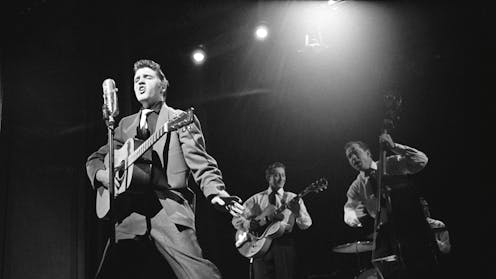
Ben Platt’s recent cover of Addison Rae’s Diet Pepsi has gone viral on social media.
The appeal was the song choice and change in performance style – an unexpected crossover between Platt’s musical theatre background and Rae’s bubblegum TikTok pop.
It’s just the latest in a long history of our enduring love for covers: songs that are performed or rerecorded by a different artist to the original one, often with a new twist.
Think Whitney Houston’s cover of Dolly Parton’s I Will Always Love You, Jimi Hendrix’s cover of Bob Dylan’s All Along The Watchtower, or Luke Coombes’ cover of Tracy Chapman’s Fast Car.
Covers can give new life to the songs we know and love. In some cases, they may even surpass the original.
Where does the concept come from?
The concept of covers originates in the American popular music industry of the early 20th century. Before recording was accessible and affordable, the music industry was really a publishing industry, with audiences buying sheet music to play popular songs at home.
The term “cover version” came into play as recording and broadcasting took over the way audiences engaged with popular music. Through record sales and early radio, film and television (especially in the 1940s and 50s), audiences could hear music played by others, and as British sociomusicologist Simon Frith puts it, increasingly popular music then “became a matter of consumption rather than technique”.
The breakthrough: Elvis Presley
The early American popular music industry was racially segregated. According to music historian Philip Ennis, music at this time was divided into six main streams broken up by genre and race preferences: pop, black pop, country pop, jazz, folk and gospel.
The big breakthrough was rock and roll, which emerged as the “seventh stream” to bring together audiences, as well as genres including country, soul and blues.
Elvis Presley was a pioneer of rock and roll because of his ability to cross these streams. His first breakthrough hit, That’s Alright Mama, was actually a cover of a song written and first recorded by Black blues artist Arthur Crudup.
In many ways, this combination of song choice and performance broke the “cover” mould. Suddenly, audiences of all types no longer wanted to hear just any version of this song. They wanted Elvis’ version.
The elevation of Elvis’ version drew attention away from Arthur Crudup and his work. It is one example in a much broader trend of Presley and other white performers covering or adapting black artists’ work without due acknowledgement.
A subtle art
There’s no real secret to a perfect cover beyond the appeal of a specific performance. An artist who performs a cover is often directly competing with pre-existing expectations around genre and style. Changing this can be hard to get right.
Record a cover too close to the original and you may be accused of being derivative – but if it’s too far-removed, fans can feel betrayed.
In practical terms, covers are a cheaper way to licence existing popular songs. When applying to record a cover version, an artist or producer only needs to approach the publisher representing the songwriter.
But if they want to use a recorded sample of a particular recording, this can involve a maze of publishing and mechanical copyright owners (mechanical copyright covers the artist who has recorded the work, rather than the person who wrote it).
Covers in the 21st century
Covers have come to take on new meaning and value in today’s recording-dominated music industry. They are a way for new artists to break into the game by leveraging audiences’ love for existing music, such as on music competitions like Idol and X Factor.
They’ve also carved out space in the film and television industry. Animated film franchises such as Trolls and Sing popularise high-quality covers of well-known songs.
Covers can also be used by artists as a nod to their history or influences. For instance, when Helen Reddy was inducted into the ARIA Hall of Fame, her song I Am Woman was performed by several generations of women artists.
On radio (and online) Triple J’s Like a Version and BBC’s Radio One Live Lounge commission covers to engage younger listeners. There is often a clear generational or inspirational through line between the artist and the artist whose song they are covering.
Earlier this year, Jessica Mauboy and Barka covered Yothu Yindi’s World Turning, with Mauboy describing her personal and political connections to the song.
Old tunes in new contexts
Covers can also be a way for artists to rebel or play, using the words and sounds of someone else to reclaim or reassert a position. The best examples of this come when an artist takes the song out of its original context and into a new one.
Nirvana’s cover of David Bowie’s Man Who Sold The World for MTV allowed the band to make a statement about feeling trapped – which their PR team certainly wouldn’t have allowed elsewhere.
We have more recordings now, and easier access to them, than any other point in human history. The choice to re-record or re-perform something from the past allows artists to connect to audiences in new ways, and for audiences to rediscover, in a fresh way, the songs they know and love.
Liz Giuffre does not work for, consult, own shares in or receive funding from any company or organisation that would benefit from this article, and has disclosed no relevant affiliations beyond their academic appointment.
This article was originally published on The Conversation. Read the original article.







